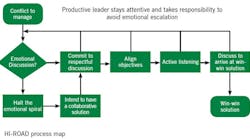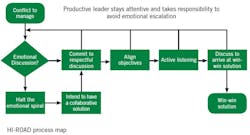Collaboration is the preferred tool for managing conflict. With collaboration, both sides can express their needs and work to understand the needs of the other party. The HI-ROAD model is used when you feel a discussion has crossed or is about to cross over from a conversation into a disagreement or conflict. The model allows the parties to slow down and regain control. The key is keeping emotions in check.
Everyone has different experiences and different levels of information from which they make assumptions or decisions. Discussions escalate into disagreement or conflict most often because of a misunderstanding. Assumptions lead to each person forming a game plan about what approach they will invoke (competing, collaborating, compromising, avoiding, or accommodating) to reach a resolution.
Logical exchanges generate the best solutions. People need to state which facts, information, or assumptions they’re basing their position on. This is the point at which escalating discussions can be brought back to a rational, logical conversation. Many times, differences are not as big as originally thought.
The most important thing is to have a common understanding of the situation, the objectives or goals, and the knowns and unknowns. Never assume everyone is seeing the same things. Productive leaders will take time to make sure that everyone is working on solving the same problem.
Having used many different conflict prevention and resolution methods, I believe the HI-ROAD process offers the best approach:
1. H – Halt the emotional spiral. When you feel yourself becoming frustrated or angry or sense the other party is, stop. Call a timeout. Say, “Let’s take a pause and think about what the problem is and what we know.”
2. I – Intend to have a collaborative solution. After a brief pause, state your mutual intention to collaborate on the solution. Say, “We need to solve this issue in the best way for all parties.”
3. R – Respect the other person. Using respectful words, vocal tone, and body language, acknowledge the other party’s position, beliefs and opinions. Say, “I know we all have the best intentions, so let’s keep the discussion professional and respectful.”
4. O – Objectives need to be aligned. Develop a common understanding of the end state that both parties are trying to reach. The other party may have objectives that you haven’t thought about. The key is to have a target that can be referred to when there is a sticking point.
5. A – Active listening. It’s important for each party to know the other party’s needs regarding how objectives are achieved. Ask the other party (or parties), “Can you explain what is important to you as we solve this problem?” Keep asking clarifying questions until you can completely and accurately state the other person’s needs. After you understand the other party’s position, switch roles. Tell the other party what you need so they completely and accurately know your needs.
6. D – Discussion. Have a dialogue that seeks win-win solutions. If either party begins to get frustrated, emotional or angry, return to Step 1, halt, and follow the HI-ROAD process.
The ROAD parts of the HI-ROAD process are similar in substance to the “interest-based negotiation” method that is common in collective bargaining negotiations. As you may know, those discussions can be very frustrating, emotional and contentious.
The HI-ROAD process is shown graphically in Figure 1. When you identify a conflict to be managed, be attentive and determine whether this will be an emotional discussion. Emotional discussions are highly likely when trust is lacking or when the issues are deeply meaningful to one or both parties. If it is expected to be an emotional discussion, start at the beginning of the HI-ROAD process. Make clear the intention to have a collaborative solution. Then proceed with each step of the HI-ROAD process in sequence.
If the discussion does not start out to be emotionally charged, it is OK to move ahead to the ROAD steps of the HI-ROAD process. Always act respectfully, align objectives, listen actively, and have a dialogue to arrive at a win-win solution.
If there is an impasse, it’s OK to stop and take a break and then return to the discussion later. People get fatigued, and they may need to verify information or get clarification or approvals before they can meaningfully proceed. Simply schedule a time and place to resume the discussion.
Learn to use the HI-ROAD process, and you’ll have much better relationships with peers and team members. You’ll come up with better solutions when emotions are in check and all parties understand each other.




